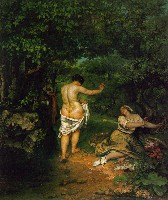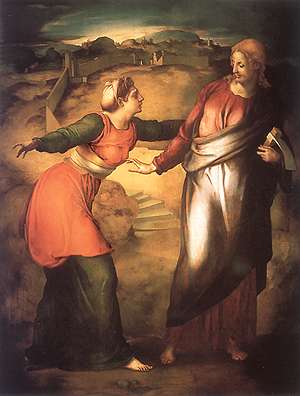|
Preface: This web page was inspired by David Marno's talk "Between the Visible
and the Invisible: Pontormo's Noli Me Tangere" on Saturday, April 26, 2008. I attended
this two-day conference "Approaching the Discourse of Transcendence" at Stanford University,
where 18 speakers presented papers on the subject of transcendence. I felt very much at home
listening to papers on Platonism, Taoism, Buddhism, Tibetan metaphysics on emptiness,
Advaita Vedanta, Upanishads, Chinese philosophy, and Christian mysticism. Having approached
these disciplines on the spiritual quest and meeting sages who have experienced the
transcendent, it was a treat to hear this topic addressed in an academic atmosphere.
David Marno's talk was focused on just one painting— Pontormo's Noli me Tangere,
but he began by telling us about "Grace" in the Renaissance, in Mannerism, and in theology.
Grace relates to faith as in the concluding line of John's Gospel. It is the basis of faith
in the believing of the invisible. Grace negotiates between the visible and invisible.
"Noli me Tangere" appears in the
Gospel of John XX.17 "Jesus saith unto her, Touch me not;
for I am not yet ascended to my Father: but go to my brethren, and say unto them, I ascend
unto my Father, and your Father; and to my God, and your God." Mary Magdalene had mistaken
the figure near the cave's sepulchre as a gardener. When Jesus said unto her "Mary", she
realized it was the resurrected Christ, and called him "Rabboni; which is to say, Master."
It is interesting that the Greek passage in John XX.17 is better translated as
"cease holding on to me or stop clinging to me". This admonition goes even beyond the
physical touching, but mental clinging to the master. The last words Buddha told
his disciples before his paranirvana were "Be the lamp unto yourself." Like painters who
copy the great masters in museums, they must go beyond imitation and find their own
style. Likewise, the disciple or student, having absorbed the lessons of his teacher,
must find innovation within himself. Since we have Buddha Nature or Christ Consciousness
within us, this is the energy source we need to tap into for creativity in our daily work
as well as insight and illumination into the spiritual realms. This is perhaps the true lesson
of Noli Me Tangere.
| |
|
Salvatore S. Nigro, Pontormo: Paintings and Frescoes Harry N. Abrams, Inc., New York, 1994, pp. 7-8, 156  Gustave Courbet The Woman Bathers (1853), Musée Fabre, Montpellier,
was first exhibited at the Salon of 1853 in Paris. The empress Eugénie did
not display any reaction to the woman in the painting turning her back to the
viewer. She only commented that the broad certainly had enough padding and seemed
to be an ostentatious dame with her ripples of flesh rather than an uninhibited
matron. Delacroix, on the other hand, could not make head or tail of it. Writing
in his Journal (Friday, April 15, 1853): "... what a painting! what a subject!
The vulgarity of its forms would not be so bad, but the vulgarity and the uselessness
of the idea are detestable. What do these two figures mean? One is a fat bourgeois
woman, seen from the back and completely nude except for the border of a nonchalantly
painted tattered cloth that covers the lower half of her buttocks. She steps out of a
shallow pool of water that doesn't even seem deep enough for a footbath and makes a
gesture that does not mean anything. The other woman, perhaps her servant, is sitting
on the ground, where she has just taken off her stockings. They can be seen lying
there, one of them only half visible, I think. An exchange of thoughts seem to be
taking place between these two figures, but the meaning is not clear to the viewer."
Gustave Courbet The Woman Bathers (1853), Musée Fabre, Montpellier,
was first exhibited at the Salon of 1853 in Paris. The empress Eugénie did
not display any reaction to the woman in the painting turning her back to the
viewer. She only commented that the broad certainly had enough padding and seemed
to be an ostentatious dame with her ripples of flesh rather than an uninhibited
matron. Delacroix, on the other hand, could not make head or tail of it. Writing
in his Journal (Friday, April 15, 1853): "... what a painting! what a subject!
The vulgarity of its forms would not be so bad, but the vulgarity and the uselessness
of the idea are detestable. What do these two figures mean? One is a fat bourgeois
woman, seen from the back and completely nude except for the border of a nonchalantly
painted tattered cloth that covers the lower half of her buttocks. She steps out of a
shallow pool of water that doesn't even seem deep enough for a footbath and makes a
gesture that does not mean anything. The other woman, perhaps her servant, is sitting
on the ground, where she has just taken off her stockings. They can be seen lying
there, one of them only half visible, I think. An exchange of thoughts seem to be
taking place between these two figures, but the meaning is not clear to the viewer."
It was especially the exaggerated ceremoniousness of the bathing women that Delacroix found warped and meaningless. Beyond the opulence of the rotund forms, contemporaries of the painting noticed a hidden play between the two women. It consisted of a negotiating of ideas that seemed reluctant to be revealed. An angry gesture is all that the painting explicityly showed. and it was as if "no", an insignificant but formidable syllable, had become a broad and resolute gesture. It constituted a prohibition to touch and to be touched, as if it were a new and profane version of the Noli me tangere. The movements of Courbet's two women undoubtedly have a touch of wickedness. And they appear blasphemous as a result of the traces and touches evident in the painting that remind the viewer of the scene where Christ and Mary Magdalene are summoned, in the tradition of sacred paintings, to proclaim that we can approach the divine only with faith. The bourgeois women of Courbet emphatically proclaim "hands off," asserting it with gestures denoting moralistic mannerism and criticism of the society. They assert it with a "sociology" that is an attempt at making blaspheming fashionable and at "superimposing" or consigning to .jpg) the imagination a remant of Florentine Mannerism, recovered (in its specifics and
details) along the lines of Agnolo Bronzino's Noli me tangere (1565, Louvre).
In the vegetation depicted in Courbet's painting, there is a splash of the green
light of Bronzino's painting, which had found a home in Paris. On the other hand,
the mute eloquence of the hands with palms held up, the contortions of the bodies,
and the austere, almost abstract, lines of the composition represent the summation
of an entire Florentine school.. There are reminiscences of painting starting with
the cartoon for Noli me tangere by Michelangelo, from which a painting was
produced by Pontormo, continuing with Bronzino's reproduction of this cartoon
through the mediation of Pontormo and ending with the reinvention of the "French"
painting, showing the cold early morning light and a rearrangement of the figures,
meaning that Christ, the "gardener", comes into the composition from the left,
as does Courbet's large woman.
the imagination a remant of Florentine Mannerism, recovered (in its specifics and
details) along the lines of Agnolo Bronzino's Noli me tangere (1565, Louvre).
In the vegetation depicted in Courbet's painting, there is a splash of the green
light of Bronzino's painting, which had found a home in Paris. On the other hand,
the mute eloquence of the hands with palms held up, the contortions of the bodies,
and the austere, almost abstract, lines of the composition represent the summation
of an entire Florentine school.. There are reminiscences of painting starting with
the cartoon for Noli me tangere by Michelangelo, from which a painting was
produced by Pontormo, continuing with Bronzino's reproduction of this cartoon
through the mediation of Pontormo and ending with the reinvention of the "French"
painting, showing the cold early morning light and a rearrangement of the figures,
meaning that Christ, the "gardener", comes into the composition from the left,
as does Courbet's large woman.
So many things that can be said with the hands! Michel de Montaigne talked about it in his Essays, where he put together an alphabet of fingers and a grammar for gestures, constituting a physiognomy and a sociology of corporeal aspects. It almost turned into a formal etiquette providing ethical definitions for the "silent" art of using the hands to mimic, and then into a more humble domestic application.
Vasari, Lives of the Artists, Vol. II, *********************************************************** Web Links to Noli Me Tangere:
•
Wikipedia: Noli Me Tangere |
| Top of Page | Poem | Poems 2008 | Haikus 2008 | Books | A-Z Portals | Home |
| © Peter Y. Chou,
Wisdom Portal P.O. Box 390707, Mountain View, CA 94039 email:  (4-28-2008) (4-28-2008) |
|
.jpg)
.jpg)
